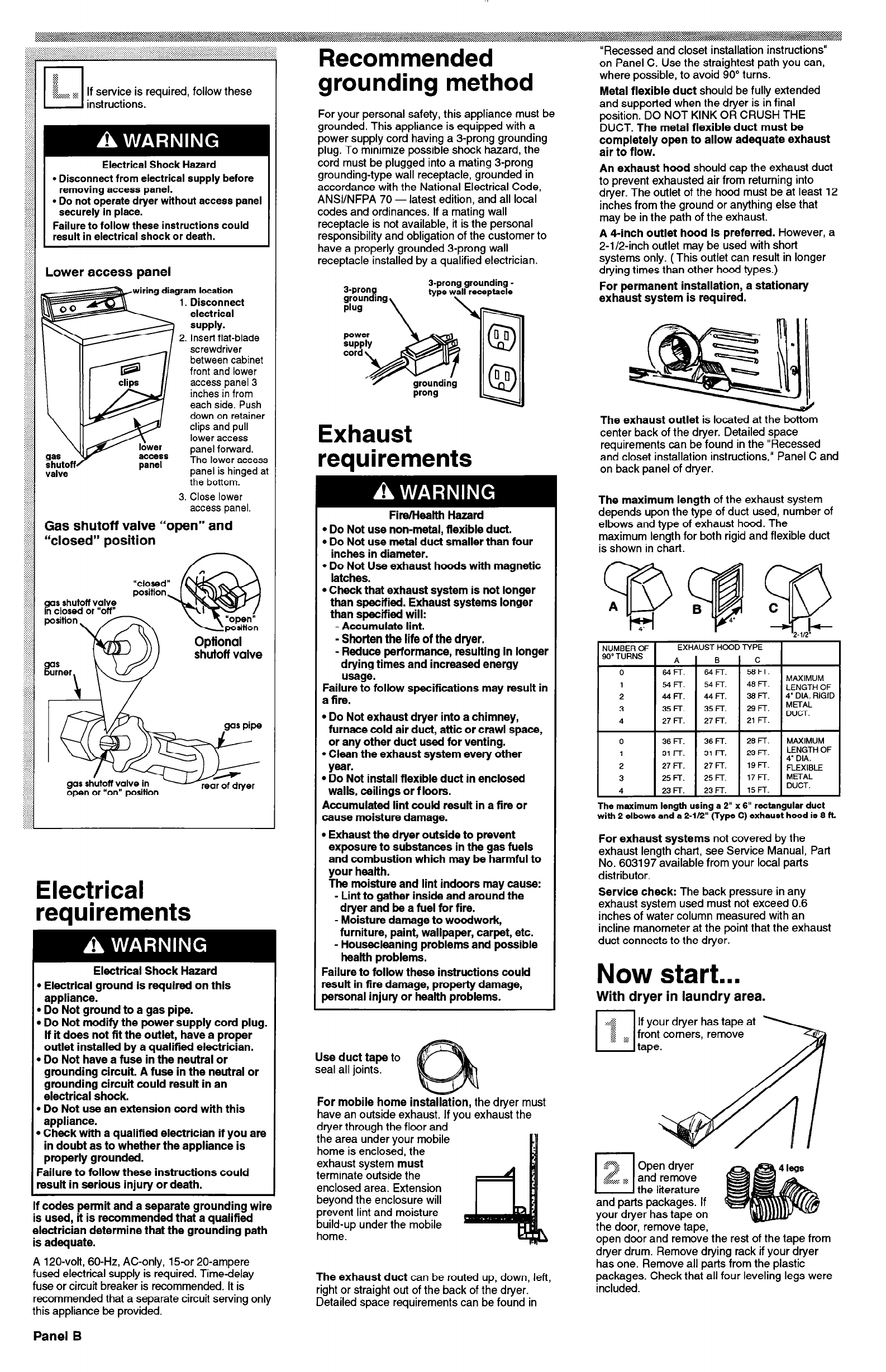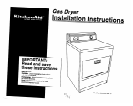
:rs
f
u
. . . . .
. . . . .
.:.: . . . . . . . . . . . . :.:<
_ u _ _ If service is required, follow these
instructions.
Electrical Shock Hazard
l
Disconnect from electrical supply before
removing access panel.
l
Do not operate dryer without access panel
securely in place.
Failure to follow these instructions could
result in electrical shock or death.
Lower access panel
wiring diagram location
1.
Disconnect
electrical
suPPlY-
2.
Insert flat-blade
screwdriver
between cabinet
front and lower
access panel 3
inches in from
each side. Push
down on retainer
clips and pull
lower access
valve
panel is hinged i
the bottom.
3.
Close lower
access panel.
Gas shutoff valve “open” and
“closed” position
“closed”
gas shutoff valve
position,
n closed or “off”
Optional
shutoff valve
Electrical
requirements
If codes permit and a separate grounding wire
is used, it is recommended that a qualified
electrician determine that the grounding path
is adequate.
Electrical Shock Hazard
l
Electrical ground is required on this
appliance.
l
Do Not ground to a gas pipe.
l
Do Not modify the power supply cord plug.
If it does not fit the outlet, have a proper
outlet installed by a qualified electrician.
l
Do Not have a fuse in the neutral or
grounding circuit. A fuse in the neutral or
grounding circuit could result in an
electrical shock.
l
Do Not use an extension cord with this
appliance.
l
Check with a qualified electrician if you are
in doubt as to whether the appliance is
properly grounded.
Failure to follow these instructions could
result in serious injury or death.
A 120~volt, 60-Hz, AC-only, 15-or 20-ampere
fused electrical supply is required. Time-delay
fuse or circuit breaker is recommended. It is
recommended that a separate circuit serving only
this appliance be provided.
Recommended
grounding method
For your personal safety, this appliance must be
grounded. This appliance is equipped with a
power supply cord having a 3-prong grounding
plug. To minimize possible shock hazard, the
cord must be plugged into a mating 3-prong
grounding-type wall receptacle, grounded in
accordance with the National Electrical Code,
ANSVNFPA 70 - latest edition, and all local
codes and ordinances. If a mating wall
receptacle is not available, it is the personal
responsibility and obligation of the customer to
have a
properly grounded 3-prong
wall
receptacle installed by a qualified electrician.
3-prong
3-prong grounding -
grounding
type wall receptacle
PM
\
8
no
i
8
00
prow
Exhaust
requirements
Fire/Health Hazard
l
Do Not use non-metal, flexible duct.
l
Do Not use metal duct smaller than four
inches in diameter.
l
Do Not Use exhaust hoods with magnetic
latches.
l
Check that exhaust system is not longer
than specified. Exhaust systems longer
than specified will:
- Accumulate lint.
- Shorten the life of the dryer.
- Reduce performance, resulting in longer
drying times and increased energy
usage.
Failure to follow specifications may result in
a fire.
l
Do Not exhaust dryer into a chimney,
furnace cold air duct, attic or crawl space,
or any other duct used for venting.
l
Clean the exhaust system every other
year.
l
Do Not install flexible duct in enclosed
walls, ceilings or f loors.
Accumulated lint could result in a fire or
cause moisture damage.
l
Exhaust the dryer outside to prevent
exposure to substances in the gas fuels
and combustion which may be harmful to
your health.
The moisture and lint indoors may cause:
- Lint to gather inside and around the
dryer and be a fuel for fire.
- Moisture damage to woodwork,
furniture, paint, wallpaper, carpet, etc.
- Housecleaning problems and possible
health problems.
Failure to follow these instructions could
result in fire damage, property damage,
personal injury or health problems.
Use duct tape
to
seal all joints.
For mobile home installation,
the dyer must
have an outside exhaust. If you exhaust the
dyer through the floor and
the area under your mobile
home is enclosed, the
exhaust system
must
terminate outside the
enclosed area. Extension
beyond the enclosure will
prevent lint and moisture
build-up under the mobile
home.
The exhaust duct
can be routed up, down, left,
right or straight out of the back of the dyer.
Detailed space requirements can be found in
“Recessed and closet installation instructions”
on Panel C. Use the straightest path you can,
where possible, to avoid 90” turns.
Metal flexible duct
should be fully extended
and supported when the dyer is in final
position. DO NOT KINK OR CRUSH THE
DUCT.
The metal flexible duct must be
completely open to allow adequate exhaust
air to flow.
An exhaust hood
should cap the exhaust duct
to prevent exhausted air from returning into
dyer. The outlet of the hood must be at least 12
inches from the ground or anything else that
may be in the path of the exhaust.
A 44nch outlet hood is preferred.
However, a
2-l/2-inch outlet may be used with short
systems only. (This outlet can result in longer
dying times than other hood types.)
For permanent installation, a stationary
exhaust system is required.
The exhaust outlet
is located at the bottom
center back
of the dyer. Detailed space
requirements can be found in the “Recessed
and closet installation instructions,” Panel C and
on back panel of dyer.
The maximum length
of the exhaust system
depends upon the type of duct used, number of
elbows and type of exhaust hood. The
maximum length for both rigid and flexible duct
is shown in chart.
Qqvjp
4'
2-112'
1 54 FT. 54Fr. 48FT.
2
44Fr. 44Fr.
36Fr.
3 35 FT. 35Fr. 29Fr.
4 27 FT. 27FT. 21 FT.
r
2
0
3 1 25 36 31 27 FT. FT. FT. FT. 36FT. 31Fr. 27Fl. 25FT. 26Fr. 23FT.
19
17FT.
FT.
I
4 23 FT.
23FT.
15FT.
MAXIMUM
LENGTH OF
4'
DIA. RIGID
METAL
DUCT.
MAXIMUM
LENGTH OF
4’ DIA.
FLEXIBLE
METAL
DUCT.
The maximum length using a 2” x 6” rectangular duct
with 2 elbows and a 2-112” (Type C) exhaust hood is 8 ft.
For exhaust systems
not covered by the
exhaust length chart, see Service Manual, Part
No. 603197 available from your local parts
distributor.
Service check:
The back pressure in any
exhaust system used must not
exceed 0.6
inches of water column measured with an
incline manometer at the point that the exhaust
duct connects to the dyer.
Now start...
With dryer in laundry area.
. ..$S
“...i’.’
. ..v
u
If your dyer has tape at
L
. . . . .
B x front comers, remove
tape.
.$5%x
ii .<<
u
$&
Open dyer
and remove
the literature
and parts packages. If
your dyer has tape on
the door, remove tape,
open door and remove the rest of the tape from
dyer drum. Remove dying rack if your dyer
has one. Remove all parts from the plastic
packages. Check that all four leveling legs were
included.
Panel B







